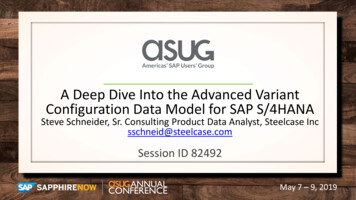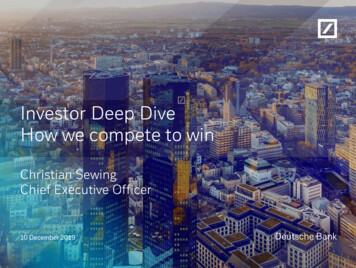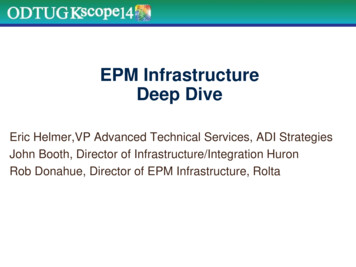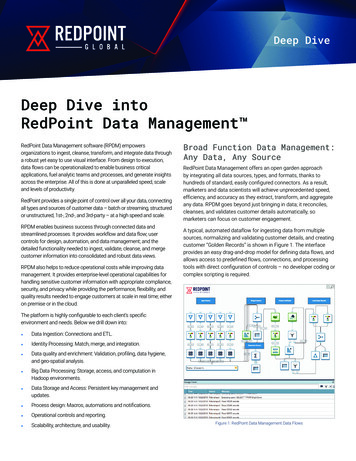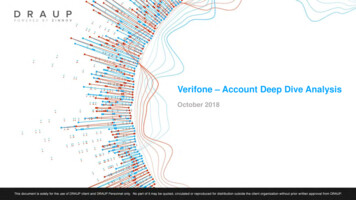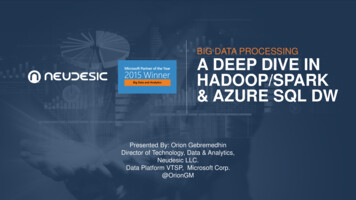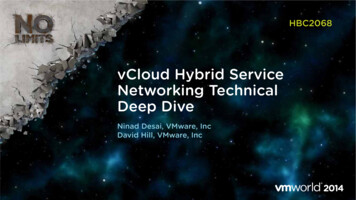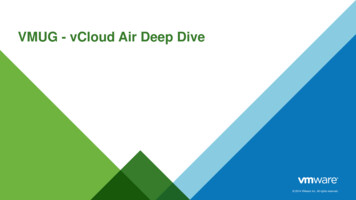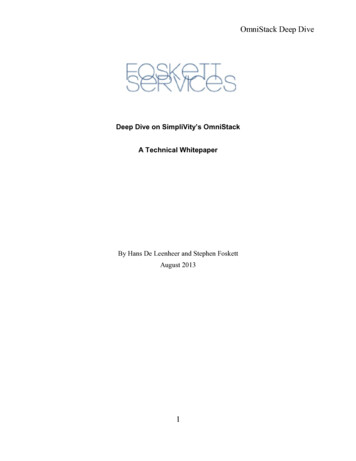
Transcription
OmniStack Deep DiveDeep Dive on SimpliVity’s OmniStackA Technical WhitepaperBy Hans De Leenheer and Stephen FoskettAugust 20131
OmniStack Deep DiveIntroductionThis paper is an in-depth look at OmniStack, the technology that powers SimpliVity’sOmniCube, a 2U data center building block that delivers a broad set of infrastructure functionsfor the virtualized environment. OmniCube is leading the emerging market for “hyperconverged” infrastructure.Appliance Sprawl and SimpliVity’s ResponseHistorically, IT environments have used a single server per workload or application. As a resultof excessive unused resources in those servers – and with the help of virtualization – datacentershave been simplified and workloads have been consolidated to just the resources necessary.Shared storage, typically in the form of an enterprise storage array, is a requirement fordatacenter virtualization. Other new challenges also brought dedicated hardware resources backinto the environment – for example, backup deduplication appliances, WAN optimizers, cloudgateways and flash cache storage appliances. All of these devices add complexity, expense, andmanagement difficulty to the virtual environment.SimpliVity brings all these functions together in a single 2U offering. OmniCube bringscomparable performance, protection, and functionality at 3x lower acquisition cost, power andspace savings, and lower overall operational cost. Plus, as an integrated system, OmniCube iseasier to manage.Converged InfrastructureA few years ago, enterprise IT was buzzing with talk of “infrastructure stacks” and “convergedinfrastructure”. These solutions sought to bring together compute, storage and networking as asingle consolidated solution. But many of the offerings in this space are simply blueprints ofdifferent components from multiple manufacturers brought together under one SKU (stockkeeping unit). The only real advantage these solutions offer is that the combination ofcomponents has been tested and verified in a lab to be supported by the respective vendors.SimpliVity took convergence a step further and developed a hyper-converged infrastructuresolution. This means that all of the infrastructure components are not only in one SKU, they areall integrated in a single physical node – the OmniCube. This hyper-converged solution includesserver and storage resources, along with a set of advanced functions for managing and protectionthe virtual machines, and includes a specialized accelerator card to optimize performance andefficiency of data storage.The SimpliVity solution doesn’t end with hardware components. A tremendous effort has beenmade to simplify the initial deployment without adding unnecessary management interfaces.Everything is centrally managed through a single pane of glass in the vCenter interface.2
OmniStack Deep DiveSimpliVity OmniStackThe OmniCube Building Block ArchitectureOmniStack is the set of technologies powering the OmniCube, and includes several innovations,which this paper will describe. OmniCube’s functionality begins with the OmniCube VirtualController (SVC). This is a VM that is deployed with the initial configuration of the OmniCubenode. All of the intelligence of the system resides in this controller.The second important part of the OmniStack is the Data Virtualization Engine (DVE), whichperforms inline deduplication and compression on the data flow. To enable high performancewith no impact to latency, OmniCube contains the OmniCube Accelerator Card (OAC), apurpose built PCIe device that contains a field-programmable gate array (FPGA) as well asseveral other components to accelerate system processing. The OmniCube Accelerator is directlyattached to the SVC and processes all of the writes that enter OmniCube in real time.Powered by this OmniStack technology, OmniCube is the SimpliVity hyper-converged buildingblock. Two or more of these building blocks (also called ‘nodes’), can be combined into adatacenter federation, creating a scalable pool of shared resources.The server hardware is a 2U standardized x86 server from a tier 1 server manufacturer, whichguarantees proven quality and serviceability for the end-user. Inside this server is performanceoptimized flash storage, with 4 solid-state drives (SSDs) in a hardware RAID-5 configuration, aswell as capacity-optimized storage with 8 or 20 hard disk drives (HDDs) in a hardware RAID-6configuration. This storage is presented directly to the SVC, making the storage hardware layercompletely transparent to the storage controller.From a network perspective, there are two Gigabit Ethernet (1GbE) ports for the VM network aswell as two ten Gigabit Ethernet (10 GbE) ports for the storage network. Additional 1GbE or10GbE ports can be added in the future.InstallationOmniCube arrives with VMware ESXi pre-installed. To get started, one must simply install theSimpliVity VMware vCenter plugin and connect the hypervisor to vCenter. It will automaticallybe detected as a new empty SimpliVity box and a guided configuration process will begin.3
OmniStack Deep DiveA new Virtual Controller will be deployed and two standard vSwitches will be installed - one forthe 1GbE NICs (VM network) and one for the 10GbE NICs (storage network). Three logicalnetworks are created as well: management, storage (front-end NFS), and federation (back-endtraffic). If the front-end NFS port group is made visible through physical switches, an existingESXi host in the datacenter could use the OmniStack datastores as well.In a matter of just a few minutes the first VMs can be deployed. Adding nodes to the stackfollows the same simple procedure.Optimized Data Flow on WriteThe data flow in the OmniStack is optimized first for low latency and performance (I/Ooperations per second or IOPS). There are four main steps when new data comes in:The IO from the VM goes through the hypervisor storage stack to the virtual controller (NFS).The controller sends the data to both a local and a remote OmniCube Accelerator on anothernode in the same datacenter.Once the local and remote Accelerator have received the data it will be acknowledged to theVM.The data gets processed for compression and deduplication by both OmniCube Accelerators andwritten to their underlying storage layer by the Virtual ControllerBecause a second host already received the data, there is no need to write the data to disk firstbefore acknowledging the IO to the VM. This will tremendously increase IOPS and decreaselatency without sacrificing reliability or risking data loss.Data OptimizationAll incoming data is processed in real-time by the OmniCube Accelerator for both deduplicationand compression. A significant benefit of real-time processing is that there is no need foruncompressed data to be stored on disk before it can be optimized post-process. Additionally,when there are multiple machines with the same type of data, such as operating system binaries,that data will only have to be written once. This saves storage space and gives the disks morespare time for read actions.4
OmniStack Deep DiveGlobal Federated ArchitectureOne of the more substantial benefits of the SimpliVity OmniStack is the data optimizedfootprint. As the blocks of data are deduplicated, they have a key in the global cache. Whenevera block of new data needs to be written that already exists, a new key is simply added to thistable.This process is exactly the same for copying the data. For example, through the support forVAAI in version 2.1 of the software, cloning a VM takes just a few seconds.Data Protection PoliciesThis is also true for data protection, even across multiple sites. For example, when a WindowsServer 2012 machine has to be copied over the WAN to another site, only the unique,compressed, optimized blocks of data will be copied. If at least one Windows Server 2012instance is already running at the other location, then none of the blocks referenced by Windowsneed to be moved over the WAN. Even then, unique blocks would already be deduplicated andcompressed making it bandwidth friendly.This means that VMs can be protected across the country or throughout the world multiple timesa day. The data protection points are always full VM images as they are the composition of allunique data blocks of that machine at any given time. There are no “full plus incremental”protection points necessary for recovery.Setting a Protection PolicyA data protection policy consists of multiple rules. A single rule holds the protection schedule,the retention period, the datacenter to copy to (local or remote), and the application consistencyrequirement for a given machine.When application consistency is checked, VMware tools will be used for quiescing theapplication and the VM before taking the VM storage snapshot. If the VM is running MicrosoftWindows, Volume Shadow Copy Services (VSS) will be used, while Linux VMs will look forpre-freeze and post-thaw scripts.The protection policies are per VM. When looking at the VM’s SimpliVity tab it will show theactive protection policy. A default policy is also set at the datastore level to prevent new VMsrunning unprotected if the administrator forgets to enable a specific policy for that VM.In the following illustration, VM-001 resides in San Francisco but could easily be started inLondon by simply copying the 4 blocks of unique data.5
OmniStack Deep DiveEconomically-Efficient RetentionIt is important to retain multiple copies of data for reliability and redundancy. Having thosecopies near production for fast recovery is equally important. Therefore, it is best-practice tohave multiple retention policies in a data protection strategy.A classic data retention policy would include 15 daily recovery points, 4 weekly, 12 monthly and5, 10 or forever yearly recovery points. But is all of that redundant data storage really necessary?What if long-term copies could be stored more cheaply than short-term recovery points?SimpliVity has thought about this and has the capability to use Amazon EC2 as one of thedatacenter locations for backup data. This significantly reduces storage cost and complexity forlong-term retention without impacting the retention schedule and data availability.6
OmniStack Deep DiveModelsSimpliVity now offers three OmniCube models:1. The CN-2000 (NEW) for Remote Office/Branch Office (ROBO) locations2. The original CN-3000 as the enterprise model3. The CN-5000 (NEW) for maximum performance infrastructures.These models differ in terms of CPU power, memory (RAM) and disk configurations.CN-2000 (NEW)The new CN-2000 is targeted at remote office / branch offices (ROBO) or small and mid-sizeenterprise (SME) environments. With a usable capacity between 5 to 10 TB depending on thelevel of optimization of the workload, this is suitable for a complete localized setup. Datacentercomponents like a Domain Controller and a DNS server, a file server, a small mail server and adocument management platform like Microsoft SharePoint all fit perfectly in this small hyperconverged platform. The only difference between the models is their size, which makes this avery useful startup environment that can scale with the company.Technical Specifications:xxxxxSingle socket 6 cores128 GB DRAM5-10 TB usable capacity: 4 x 100 GB SSDs 8 x 1 TB HDDs2x 1GbE and/or 2x 10GbEOmniCube Accelerator v2.0CN- í nd generationFirst launched in August 2012, the CN-3000 is the SimpliVity flagship. It is the base buildingblock for a mid-sized or larger environment. Where the first generation CN-3000 had 12 cores7
OmniStack Deep Divetotal, the new CN-3000 offers 16 or 24 CPU cores. Customers can also now specify various SSDconfigurations, adding capacity for flash cache. With the big 3 TB HDDs, total system capacitycan reach 40 TB or more after data optimization. Of course the CN-3000 2nd generation has thenew v2 OmniCube Accelerator as well.Technical specifications:xxxxxxxDual socket 8 or 12 core processors (16-24 total cores)From 128 GB to 768 GB RAM4x 200 GB / 400 GB / 800 GB SSDs (max 3.2 TB raw SSD capacity)8x 3 TB NL SAS2x 1GbE and or 2x 10GbEOmniCube Accelerator v2.0Option to add additional 10GbE or 1GbE portsCN-5000 (NEW)While the CN-2000 has been added for smaller environments, now there is also the higherdensity CN-5000 with more power in the same footprint. These nodes have higher CPUconfigurations and bigger RAM options. But the biggest difference is that they come with 2010,000 rpm disks for even better I/O performance.Technical specifications:xxxxxxxDual socket 10 or 12 core processors (20-24 total cores)From 384 GB to 786 GB RAM4x 400 GB or 800 GB SSDs (max 3.2 TB raw SSD capacity)20x 900 GB 10k SAS2x 1GbE and or 2x 10GbEOmniCube Accelerator v2.0Option to add additional 10GbE or 1GbE ports8
OmniStack Deep DiveUse CasesSimpliVity’s OmniStack is designed to address a wide range of environments and use cases, andthe flexibility of OmniCube models allow end users to select the right solution for theirrequirements. Below are two common use cases that would benefit from the OmniStacktechnology.The Retail StoreMany enterprises with retail locations initially deploy centralized servers and data management.They deploy a single datacenter and use web applications for local stores running on thin clientsat the remote site. Although this might look cheaper from an infrastructure model, the costs candramatically increase when stores are cut off from the Internet.Therefore, a preferred model for retailers is to deploy a small local server rack in each location.But this has proven very expensive and difficult to manage, with many different infrastructurecomponents residing in a back room or office.With a single SimpliVity CN-2000 unit per store, cost and management is reduced and capabilityand flexibility improves. Each store would only have a single device, including server, storage,and data protection. Each is linked to the whole OmniStack infrastructure yet each can runindependently when connectivity goes down.Mergers and AcquisitionsWhen one company acquires another, or when two companies merge, there is always theproblem of duplicate infrastructure and the management costs associated with this. Chances arevery high that the hardware is not the same and that the CIO will have to decide which hardwareto keep and which to remove.By bringing in SimpliVity OmniCube at the remote locations, VMs can be moved nondisruptively through storage- or enhanced-vMotion. Once all the machines are moved to the newOmniCube only the unique data of those machines needs to be transferred to the existingheadquarters. With a single reboot of the VMs, the whole existing infrastructure has beenmigrated seamlessly to headquarters.9
OmniStack Deep DiveSummarySimpliVity’s OmniStack is a novel hyper-converged enterprise IT infrastructure architecturedesigned for virtualized environments and distributed enterprises. Consisting of two or moreOmniCube nodes, an OmniStack-powered infrastructure incorporates server, storage, andnetwork resources, along with a broad set of core infrastructure functions, in a compact physicalfootprint. Each OmniCube includes advanced SSD caching and data optimization features aswell as VM-centric management integrated with VMware vSphere for performance and ease ofuse. SimpliVity’s advanced federated architecture enables distributed companies to leveragededuplication and compression for bandwidth efficient remote replication, data migrations anddata sharing.10
SimpliVity brings all these functions together in a single 2U offering. OmniCube brings comparable performance, protection, and functionality at 3x lower acquisition cost, power and space savings, and lower overall operational cost. Plus, as an integrated system, OmniCube is easier to
